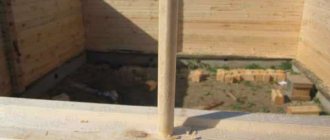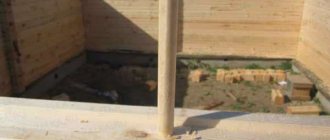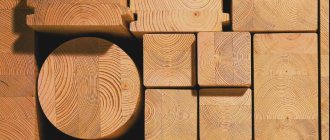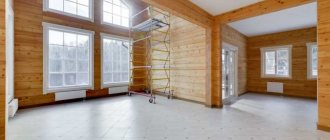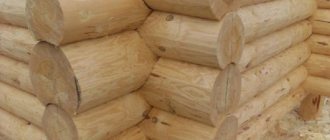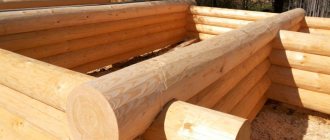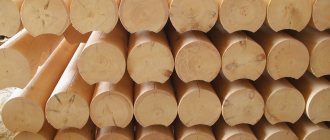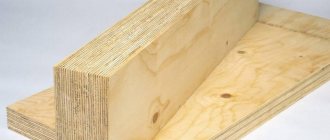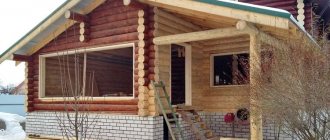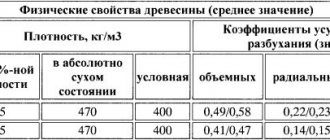Wooden bath complex
“Wooden hut. White deep snow. Frost and smoke curling over the chimney. And you come up with a bath broom and are about to open the heavy wooden door. Yes... This is a bathhouse, this is happiness and your well-deserved rest for the past working week. So?".
I am glad to welcome again dear reader!
I think I’ll be right if I say that about half of the owners of country houses sooner or later think about building a bathhouse. And many see it as wooden. This is where the question of choosing material arises. And there are only two of them. So, our topic is a bathhouse made of timber or logs, which is better? Go. Let's find out some of the nuances...
Criteria for comparing a bathhouse made of timber and logs
Let's ignore the factors that are important for manufacturers and builders. They have their own interests. To compare timber and logs, we will take only those criteria that are important for those who will use a wooden bathhouse, spend money on its construction, finishing, repairs, insulation, and so on.
For an objective comparison, the following 10 criteria will be sufficient:
- Selecting a finished project.
- Material cost.
- Complexity and cost of construction.
- Timing for the assembly of the log house.
- Shrinkage of the bath.
- Dates for commissioning.
- Difficulty finishing.
- Cross section and cold bridges.
- Thermal insulation properties.
- Appearance.
Now in detail for each point. Conclusions will not be long in coming.
Results
Based on the results of all of the above, we can conclude that profiled timber for the construction of a bathhouse is objectively better . It is more technologically advanced, easier to work with, lighter and warmer than logs.
However, many people like rounded logs because of their appearance . And according to all the criteria described above, this material is not critically behind timber. Therefore, if you like a log, it is not only possible to build from it, but also necessary. Moreover, modern technologies and developments in this area compensate for many of the disadvantages of rounded logs - shrinkage, cracking and other advantages and disadvantages equally, so that it looks like an objective comparison)
Selecting a finished project
As you know, it is impossible to build a full-fledged and well-thought-out wooden bathhouse without a project. There are several ways to get a project. If we consider the cheapest of them, then it consists in finding a ready-made solution. Remaking, for example, your favorite bathhouse design from a log to a beam will cost money. Well, development from scratch for specific requirements, budget and wishes is a whole story. Long and expensive.
It just so happens that the modern trend is that saunas made of profiled timber are more popular. Accordingly, today there are more ready-made projects made from timber than from logs. This means that choosing something more suitable from the available solutions is easier if it is timber. And this can be safely attributed to the advantages of this lumber.
Types of logs: differences, features
The log is a solid piece of wood with a rounded shape. However, it is processed using various methods, so this material is divided into subspecies.
The choice will determine the appearance of the bathhouse, its performance characteristics, as well as its final price. So, what kind of logs exist for the construction of buildings, including bathhouses?
Rounded logs
Photo of a calibrated log with cups, grooves and compensation cuts at the ends.
This log is processed on specialized machines, as a result of which it acquires a perfectly flat and smooth surface. In addition, this version of lumber has an equal diameter along its entire length, which is why it is also called calibrated log. Due to these qualities, baths made from it turn out to be beautiful and look very noble.
The technological process of processing this type of lumber often also includes trimming, sometimes profiling along the entire length, as well as the production of cups, with the help of which the crowns are fastened during the construction of log houses.
Please note that cups are divided into two types:
- simple (cylindrical or round, depending on how the milling occurs);
- and complex (the profile is made multi-stage).
In the second case, the cups provide the structure with the best wind resistance and tightness of the logs. If you choose the option with a simple cup, then to ensure good thermal insulation you will need to lay a double layer of bath insulation between the crowns. High-quality logs with complex cups are now made mainly by Finnish manufacturers.
Photo of a bathhouse made of calibrated wood.
All these characteristics make the construction of any building easier and faster, since there is no need to adjust such logs to each other and they are assembled like a construction set.
Additional advantages of rounded logs also include the following qualities:
- no chemical adhesives are used during the processing process, which is very important for a bathhouse, since during its operation they will release toxins;
- no wall finishing required;
- Thanks to minimal gaps, the bathhouse will have increased thermal insulation.
However, this log also has its drawbacks:
- During the processing process, not only the bark is removed, but also the bast (the top layer of wood), which is protective and does not allow the material to rot, so the durability of this lumber is not so high. Moreover, the bathhouse constantly contains an environment with high humidity.
- Improper drying and processing of logs can lead to them cracking after installation, and possibly even bending. Therefore, you need to purchase such material for a bath only from trusted manufacturers.
Note! Some simply call calibrated logs wood selected according to the same diameter, so when purchasing, be sure to clarify what exactly is meant.
Planed logs
The process of constructing a bathhouse from planed wood.
This type of lumber is processed not on machines, but using a jigsaw manually. At the same time, although the protective layer on such a log is removed, it is not so thick that its performance characteristics are greatly affected.
However, it is very difficult to achieve a perfectly flat surface using this method and diametrical differences are still present, which reduces the external characteristics. In addition, when building a bathhouse, you will also have to cut out the bowls yourself, and this increases both time and labor costs.
But at the same time, this allows you to make the cups as accurately as possible and secure the crowns tightly, thereby ultimately obtaining a strong and warm bath. In a word, in terms of its performance characteristics, a planed log is better than a calibrated log, but in terms of appearance it is inferior to the option described above.
Scraped or chopped logs
Photo of a scraped log.
This version of lumber is made by hand by removing the bark with either an ax or a scraper. Any benefits of civilization in the form of electric jigsaws and so on are not used, this is the whole value of scraped wood.
After all, this preserves the top protective resin layer, which resists the influence of the external environment well. Thanks to this processing method, the logs crack less during the drying process.
Note! The cost of a bathhouse made from chopped wood is the highest. Also, the construction of such a structure will take more effort and time.
Photo of the semi-carriage.
There are several types of cutting, which allows you to create even different ornaments and patterns on the material. Varieties of chopped logs also include carriage and semi-carriage (sometimes done using power tools). In the first option, the protective layer on the log is cut off both from the outside and from the inside, and in the second – only from the room side.
To make a carriage, it is better to choose larch, since its inner layers are stronger than the upper ones. However, this breed is not affordable for everyone, so to save money, you can choose pine, which has a lower price. But in this case, it is more advisable to use a half-carriage, which will allow the logs to maintain a protective layer on the outside of the structure.
The advantages of this type of log include the following characteristics:
- The scraped log does not have to be treated with antiseptics, since it can already last a long time. Special treatment allows you to increase this figure to 100 years.
- Logs processed by felling make it possible to build a unique bathhouse.
- Walls made from scraped logs do not require sheathing.
The process of building a bathhouse from a gun carriage.
Note! Whatever log is chosen for the bathhouse, in any case, structures made from such lumber are characterized by severe shrinkage (at least 10%). This takes about a year (at least 6 months).
Complexity and cost of construction
Any builder who is directly involved in working with timber or logs will definitely say that it is easier to work with timber. Especially when it comes to adjusting the crowns to each other, as well as selecting joining grooves directly on the construction site. The beam in this regard is simpler and more understandable.
It follows that the cost of builders’ services is lower if it is timber, and higher if it is log. In addition, due to the constantly declining popularity of logs as a building material for baths, there are fewer and fewer specialists who can work with this material at the proper level. And this is another prerequisite for a completely fair increase in construction costs.
General description of a log bathhouse
Information.
A log bathhouse is good because its walls heat up faster, breathe, and absorb moisture. It is easier to maintain the desired microclimate in a log structure.
The logs of adjacent crowns are joined along a semi-cylindrical surface 12–14 cm wide. The joints are closed from moisture, since the groove is selected from the underside of the log. Carefully caulked, they do not become bridges for heat escape. The connections of crowns in bathhouses made of chopped logs are insulated with moss, linen tow, jute tape, felt).
The log must be a construction log (for construction), and not a saw log (for creating lumber). For a bathhouse, a “twenty” log is often chosen, less often a 24-centimeter log.
Moisture content of lumber
The moisture content of wood directly affects its cost, as well as the time of natural shrinkage of the walls of the house after installation. Logs, both rounded and unbarked, are sold to the consumer with natural humidity, which ranges from 30 to 80%, depending on the time of year in which the tree was cut. In winter, the movement of juices in the plant trunk stops, so this is the most favorable period for harvesting.
The timber can be dried both in drying chambers and without them. The drying method directly determines the time after which wood with the required moisture content will be ready for further processing. Drying chambers make it possible to reduce this figure to the normal value of 10 - 12% within 1 - 2 months, while a large amount of energy is consumed, which leads to a significant (twice) increase in the price of the starting material.
Environmental friendliness of various lumber
The environmental friendliness of a wooden house is a defining characteristic and the main motivating reason for building a wooden house for housing. It is all the more important for the developer to know some of the features of using certain lumber. Let's start in order.
The most expensive material in terms of cost, laminated veneer lumber is produced by gluing together 2 to 5 boards, resulting in a durable and deformation-resistant material. But the use of adhesives, which are usually synthetic, calls into question its environmental friendliness and the absence of harmful fumes during the operation of a building made from it.
Regular, profile and rounded logs are obtained as a result of the processing of a tree trunk. Its internal structure is more porous than the wood located under the bark, and therefore requires additional impregnation with liquids that prevent rotting. The use of these liquids (and they need to be used every 3 to 4 years) also negatively affects the environmental friendliness.
And only a log from which only the bark has been removed mechanically can be considered fully compliant with the standards. A dense resinous layer remains on it, which prevents increased absorption of moisture into the wood, which makes its impregnation unnecessary.
Building dimensions
What size bathhouse is best to choose for construction? Let's start with the height of the ceilings. To make it comfortable to move around in the room, even if your family members are of average height, you should not make the walls lower than 2.1 m. After all, it is necessary to take into account that the shelves in the steam room are made at a level of 1 m from the floor. A person should sit on it without bending over. Plus, you need to leave free space under the ceiling for the sweep of the broom. You should not make the ceiling higher - it will take longer to heat the room.
Now let's talk about the length and width of the building. As a rule, a bathhouse consists of 3 rooms: a dressing room, where you can undress and relax after the bath, the steam room itself, and a sink. According to the standard, the ratio of such premises is 2:1.5:1. That is, the dressing room is made a little larger.
Steam room dimensions
The size of the sink should be sufficient for at least a couple of people to sit comfortably on benches with basins. There is 1 sq.m. per person. m of free space. It is necessary to leave free space for containers with water. If desired, a shower room or a small pool can be made.
The dimensions of the steam room are minimal. If several people will visit the bathhouse at the same time, then each of them must be allocated 1.5 m2.
The width of the steam room depends on the size of the shelf. Some people like to steam while sitting. In this case, it is enough to build a bench 40-45 cm long. For those who like to lie in the steam room, its length is 95 cm. You can use the space rationally if you build shelves in the letter “L”. In this case, even small benches can accommodate two people. You can make a couple of shelves on opposite walls. For free passage between them, you must leave 80 cm.
The dimensions of the steam room itself depend not only on the size of the shelf, but also on the type of oven. It is also necessary to take into account the recommended distance from it to combustible structures (wall cladding). This is done for fire safety purposes.
You should also focus on the length of the logs. As a rule, it is 6 m.
What material to choose to build a bathhouse (reviews)
Nothing helps you make a choice more than reviews from people who have experienced something themselves.
Before building my own bathhouse, I thought that it had to be made of wood, but wood breathes.
But no matter how much I walked around such baths, no matter how long I stayed inside, I never saw (didn’t feel) this breath. Today I am sure that a bath is the conditions that should be created in a steam room, the optimal ratio of humidity and temperature. The project was born quickly, because I clearly understood what I wanted from it: a steam room and a wash room must be separate, a large and comfortable relaxation room, a firebox must have a fireplace effect and... the opportunity to spend time comfortably in the winter. A bathhouse in winter is a song. That’s why I chose foam blocks for the walls. Konstantin
https://www.forumhouse.ru/threads/394720/
My steam room/sink is a log house made of aspen d=250\300 and the dressing room is a frame building.
I did not pour concrete under the pouring floors, but welded a frame of 12 reinforcement bars with slopes in the center towards the scupper (aka ladder) and stretched a thick plastic film. I also made “eternal” joists under the floors, fortunately we sell inexpensively used thick-walled timber (76\6 mm), welded strip pads to it along the edges (so as not to spin) and scattered 6 pieces. with an interval of 0.5 m (the ends of the pipes lay on the lower strapping beam, in the places where half-logs are placed near the log house). Another “know-how” is to ensure that the floorboards of the pouring floors are not attached to the joists (you can always lift them to dry, or clean the drain under them) and so that they do not run together and lie at equal intervals. Along the edges of the boards (with an indentation of 10 cm) you drilled and inserted PVC “mushrooms” to attach the insulation to the facades, then you measure 10 mm and cut the mushroom with a hacksaw. The result is a board with spaced chips along the edges, simple and reliable, it won’t rot and holds tightly. Andrey
https://www.forumhouse.ru/threads/282522/page-2
In fact, from a quality point of view, frame 100 or timber 100, raw, unplaned, and frame 200 are the optimal technologies, respectively, for an unheated and heated bathhouse.
Viant
https://www.forumhouse.ru/threads/389121/
Good afternoon
The wood concrete material for a bathhouse is not bad, but you need to use it wisely. Namely, it is possible to insulate if the wood concrete is not plastered, it breathes wonderfully, the cake will turn out like this: internal lining (solid wood) ventilation gap 1.5–2 cm, vapor barrier, basalt insulation 5–10 cm, wood concrete, windproof film, ventilation gap 2–5 cm, outer skin. Why is basalt insulation used? Because the thermal conductivity of the insulation is much lower than that of wood concrete, therefore there are fewer losses and faster warming up. If you plaster the outside, then such a structure will not be able to breathe towards the street and will accumulate moisture, and it can even penetrate through the vapor barrier, since small leaks and damage are possible. In terms of vapor permeability, materials must follow each other in order of increasing vapor permeability (from the inside to the outside); there are no plasters comparable in vapor permeability to wood concrete. Tooth
https://www.forumhouse.ru/threads/100295/
Regarding the construction of a bathhouse from laminated timber.
A definite plus, from my point of view, is minimal shrinkage and understandable behavior of the timber in the future. Of course, provided that the timber is of high quality. Konstantin
https://www.forumhouse.ru/threads/390466/
Durability of wood
The service life of a log house made from various lumber is longer, the less processing they have been subjected to. Therefore, the most durable log will be a debarked log, from which the dead bark is removed manually and there is no structural damage to the surface, most dense layer of wood. It is this layer that prevents moisture from penetrating into the deeper and less dense parts of the log, thereby preventing the processes of rotting and decomposition.
In the process of rounding logs, the denser surface layer is removed to looser sapwood, so the service life of logs made from them is up to 50% lower. All types of timber, except laminated veneer lumber, have approximately the same durability. Glued laminated timber stands out here too - during the gluing process, the lamellas are treated with chemical compounds, so buildings made from it will last no less than those made from a debarked trunk.

